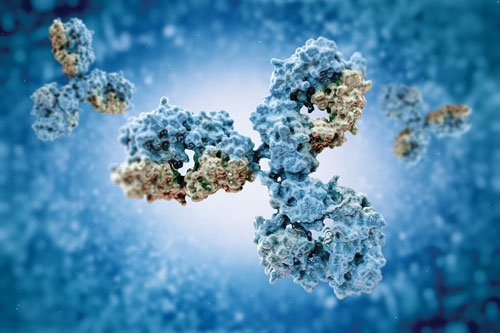Researchers at Duke Human Vaccine Institute (DHVI) have identified a new type of anti-glycan antibody (Ab) that binds to a patch of the chain-like sugars on the outer shell of HIV, effectively neutralizing the virus. The newly identified antibodies, which the team found in both macaques and humans, could lead to development of a novel vaccine strategy that might potentially be used against SARS-CoV-2 and fungal pathogens.
“This represents a new form of host defense,” said Barton Haynes, MD, director of the Duke Human Vaccine Institute (DHVI). “These new antibodies have a special shape and could be effective against a variety of pathogens. It’s very exciting.”
Senior author Haynes and colleagues, report on their discoveries in Cell, in a paper titled, “Fab-dimerized glycan-reactive antibodies are a structural category of natural antibodies.”
Many pathogens, including HIV Envelope (Env), the SARS-CoV-2 spike protein, and yeast, express surface glycans, the authors wrote. In fact more than 50% of the outer layer of HIV is comprised of glycans. Haynes said that it has long been an appealing approach to find a way of unleashing anti-glycan antibodies to break down these sugar structures and trigger immune B-cell lymphocytes to produce antibodies that would then neutralize HIV. However, as he also pointed out, “Of course, it’s not that simple.”
This is because HIV is cloaked in sugars that look like the host’s glycans, creating a shield that makes the virus appear to be part of the host rather than a deadly pathogen. “… glycans found on HIV-1 and other pathogens are also present on host molecules, suggesting that the induction of Abs targeting pathogen glycans may be controlled by immune tolerance mechanisms,” they noted. Haynes and colleagues—including first author Wilton Williams, PhD, director of the Viral Genetics Analysis Core at DHVI, and co-author Priyamvada Acharya, PhD, director of the Division of Structural Biology at DHVI—discovered the new type of anti-glycan antibody through a series of studies exploring whether there might be an immune response targeted to glycans that cover the outer surface of HIV.
The newly identified group of anti-glycan antibodies—referred by the Duke team as Fab-dimerized glycan-reactive (FDG) antibodies—had previously gone undiscovered as a potential option against HIV. To date, there had been only one report of a similar anti-glycan HIV antibody with an unusual structure, which was identified 24 years ago, and designated 2G12. “2G12 is a broadly neutralizing Ab (bnAb) that targets a conserved glycan patch on Env of geographically diverse HIV-1 strains,” the team noted. “The Ab 2G12 has been the only example to date of an HIV-1 bnAb that interacts solely with glycans on Env.”
The Duke team has now isolated several FDG antibodies and found that they display a rare, never-before-seen structure that resembled 2G12. This structure enables the antibody to lock tightly onto a specific, dense patch of sugars on HIV, but not on other cellular surfaces swathed in host glycans. “… that FDG Abs can bind multiple glycan clusters and use multiple BCRs [B cell receptors], combined with FDG precursors being well represented in human B cell repertoire make this new category of glycan-reactive B cells an attractive target to consider for induction by HIV-1 vaccines,” the investigators stated.
“The structural and functional characteristics of these antibodies can be used to design vaccines that target this glycan patch on HIV, eliciting a B-cell response that neutralizes the virus,” Williams said. “These antibodies are actually much more common in blood cells than other neutralizing antibodies that target specific regions of the HIV outer layer … That’s an exciting finding, because it overcomes one of the biggest complexities associated with other types of broadly neutralizing antibodies.”
Williams said the FDG antibodies also bind the pathogenic yeast, Candida albicans, and to viruses, including SARS-CoV-2. “… we identified a new category of prevalent glycan-reactive Abs that target diverse pathogens including HIV-1, SARS-CoV-2, and yeast,” the authors stated. Additional studies will explore ways of harnessing the antibody and deploying it against these pathogens.
The team in addition pointed out that since they submission of their work for publication, other researchers have reported that the FDG antibody 2G12 can also neutralize strains of influenza, “ … further demonstrating the breadth of cross-binding activity of the 2G12 FDG Ab for glycosylated virus pathogens,” Williams et al. concluded.



